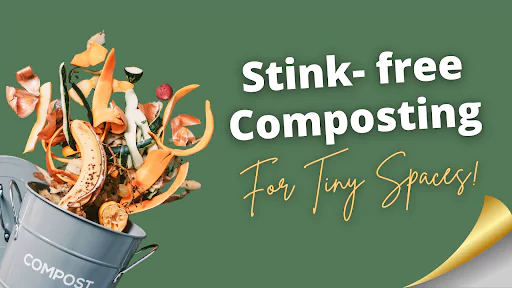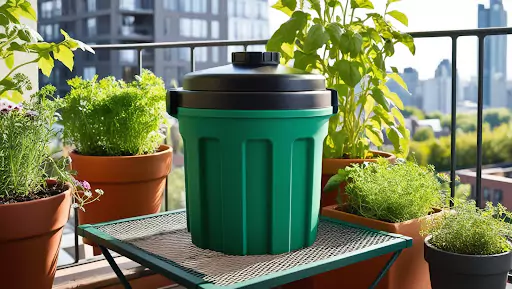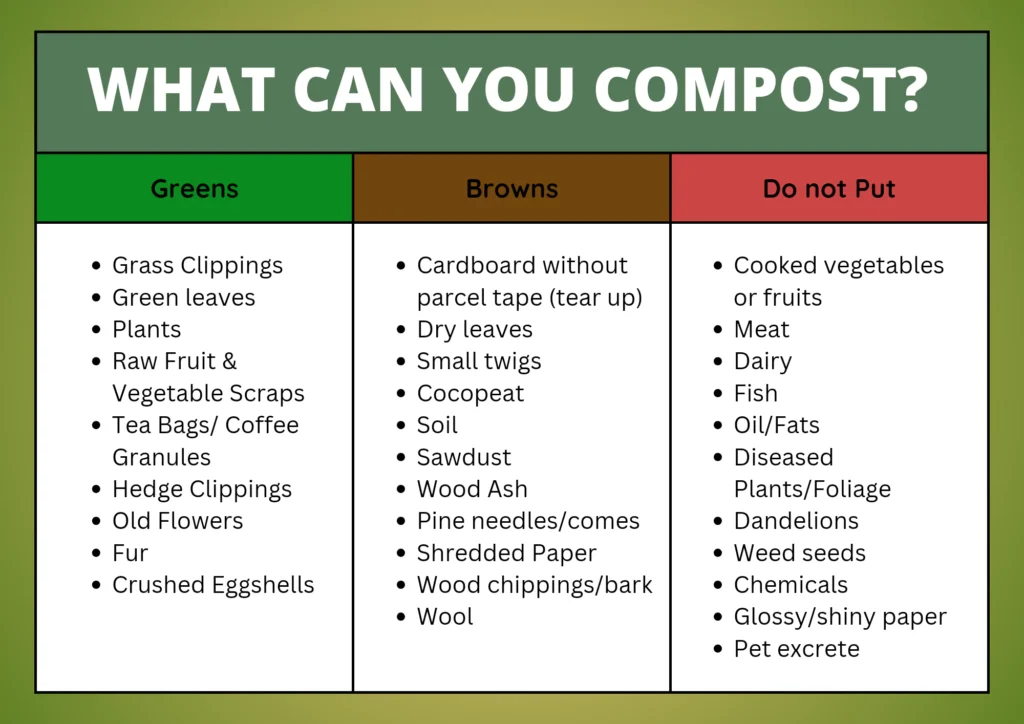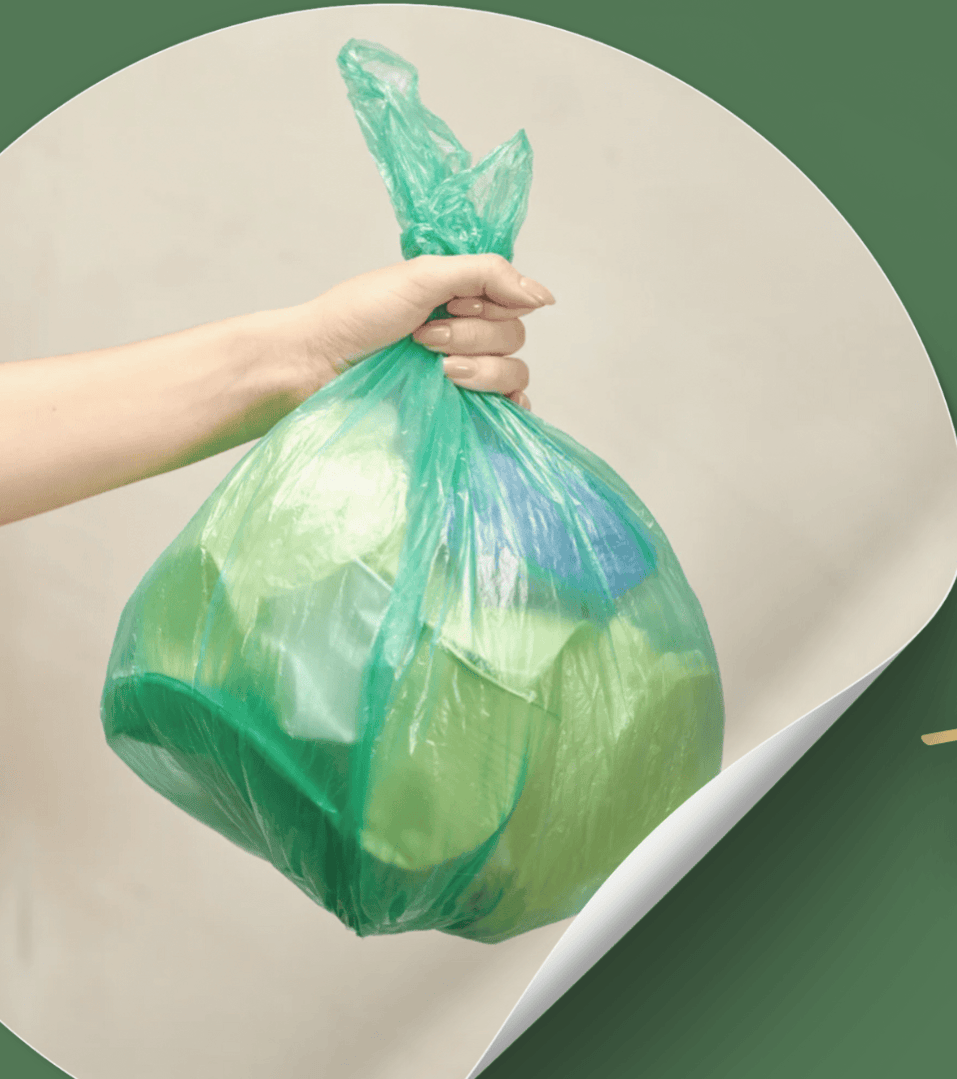
I’ll admit it—seeing all the kitchen scraps go to waste truly bothered me. I kept putting off composting in my apartment because I was worried about the odors, bugs, costs, and whether I could stick with it once I started.
If you’ve felt the same way, you’re not alone. Many of us find composting in small spaces overwhelming. But what if I told you that composting kitchen waste in apartments could also be simple and smell-free.
As Rebecca Louie, author of Compost City, puts it, “When done properly, composting is easy, doesn’t smell bad, can be discreet and is a lot of FUN.”
With organic waste making up 60% of landfills and contributing to greenhouse gas emissions, learning how to start composting in an apartment is a powerful way to make a difference.
Let’s explore the steps to turn those scraps into something beneficial for both your plants and the planet !
Step-1: Choose the Composting Method That Fits Your Space
1- DIY Indoor Compost Bin
Creating a DIY indoor compost bin is a great way to recycle kitchen waste without taking up much space. Here’s how to build one using an old bucket or planter:
-
Gather Materials: Use a large plastic bucket or planter with a lid. You’ll also need a drill and some newspaper or cardboard.
-
Add Ventilation: Drill small holes in the lid and sides of the container for airflow, which is crucial for composting in an apartment.
-
Prepare the Base: Place a layer of newspaper or cardboard at the bottom to help with drainage and aeration.
This simple setup will allow you to compost in an apartment efficiently!
2- Get a Ready-Made Bin
If DIY isn’t your thing, purchasing a pre-made indoor compost bin might be the perfect solution. Here’s a handy comparison of a few options:
-
Compost Tumbler
Pros: Odorless, easy to turn, and generates heat efficiently.
Con: Requires some outdoor space. -
Countertop Composter
Pros: Compact and processes waste quickly.
Con: Limited capacity. -
Barnyard Designs Compost Bin
Pros: Smell-absorbing filters and an inner bucket for easy cleaning.
Con: Low capacity.
3- Vermicomposting – Using Nature’s Helpers
Vermicomposting is a fantastic option for those willing to embrace the idea of worms. This method uses red wigglers to break down food scraps and create nutrient-rich castings.
While it’s highly effective, it can be intimidating for those squeamish about worms. If that’s you, don’t worry!
Composting in an apartment without worms is entirely doable with other methods (including the few methods mentioned earlier.)
Other Composting Options to Consider
- Bokashi Composting: This method uses a fermentation process that pre-treats food scraps. While it’s suitable for indoor use, it requires an additional step to finish the composting.
- Electric Composters: Fast and convenient, these devices transform food waste into compost-like material quickly. However, they use electricity, which might be a concern for some eco-conscious individuals.
Step 2: Find the Perfect Spot for Your Compost Bin
The ideal location for your compost bin can make all the difference. Aim for a spot that’s convenient yet out of the way—think a corner of your kitchen/ under the sink or in the balcony.
Remember, you want it to be easily accessible so that adding scraps becomes a hassle-free part of your routine.
“If you don’t have a place to put food scraps when you’re in the middle of chopping fruits and veg, they’ll probably end up in the trash,” says Lauresa Larson, co-founder of Black Thumb Garden Club.

Pro Tip: Consider a bin with a filtered lid to keep flies away or use a container in the freezer to collect scraps until you’re ready to compost.
Step: 3 Balance Your Composting Ingredients
Achieving the perfect compost balance involves mixing your “greens” (nitrogen-rich materials) and “browns” (carbon-rich materials). Here’s how to get it right:
- What to Store: Keep your kitchen scraps organized. Store fruit and vegetable scraps, coffee grounds, and eggshells in one container. For browns, have a separate stash of dried leaves, cardboard, and paper.
- Chop and Layer: Cut scraps into smaller pieces to speed up decomposition. Add layers of green and brown materials like a lasagna—this technique promotes airflow and efficient breakdown.
“Produce stickers are made of plastic. That means they do not break down in the compost.” —Melissa Corichi, founder of Let it Rot, a curbside community compost collection program.

Step 4: Manage Moisture and Aeration
Keeping your compost at the right moisture level is crucial. If your compost bin starts to smell, it might be too wet. Add dry leaves or shredded paper to absorb excess moisture.
Ensure your bin has a tight lid to deter pests and periodically check for leachates. Remove any excess liquid to maintain the right balance.
“Air and moisture are key to the biological activity needed to breakdown organic matter… Regular turning is key to speeding up the composting process.” —Jez Taylor, Head of Market Garden at Daylesford Organic Farm
Step 5: Using Your Finished Compost
Once your compost looks dark and crumbly, it’s ready to use! Here are some ways to make the most of it:
- Feed Your Indoor Plants: Enrich potting soil by mixing in some compost.
- Donate to a Community Garden: Share your compost with local gardens or green spaces.
- Start a Balcony Garden: Use the compost to grow your own herbs or small vegetables.
Troubleshooting Common Composting Issues
Controlling Odors-If your compost starts to smell, it may be too wet or lacking enough carbon-rich browns. Add dry materials like shredded paper or dry leaves to absorb excess moisture.
Keeping Pests Away-To prevent pests, ensure your bin has a tight-fitting lid and avoid adding meat or dairy products.
Speeding Up Decomposition-If your compost is breaking down slowly, chop food scraps into smaller pieces and turn the pile regularly to introduce more oxygen.
Conclusion
Composting isn’t about doing it perfectly. It’s about making small steps toward a more sustainable lifestyle. Don’t let the fear of getting it wrong stop you. Every little bit helps, and even if you encounter setbacks, you’re still making a positive impact.
For other ways to minimize waste in your home, check out our tips on reducing trash.
FAQs
-
What are the signs that my compost is ready to use?
Your compost is ready when it’s dark, crumbly, and has an earthy smell. You should no longer recognize the original scraps, indicating successful decomposition.
-
Can I compost citrus peels in my apartment?
Yes, but use them sparingly! Citrus peels can add acidity and deter pests, but too many can disrupt the balance of your compost.
-
What’s the best way to layer materials in a small compost bin?
Start with a layer of coarse materials for drainage, followed by alternating layers of greens and browns. Aim for a ratio of 2:1 browns to greens for optimal decomposition.
-
Is it possible to compost during winter in a small space?
Yes! Insulate your bin with straw or blankets to keep it warm, and continue adding kitchen scraps. Microbial activity slows but doesn’t stop entirely.
